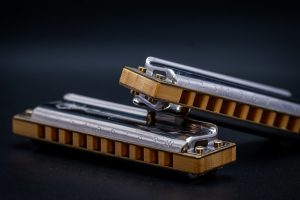The Shire’s Mathom-house: The “Battle Harmonicas of Bywater”

- Title: The Battle Harmonicas of Bywater
- Creator: Crafted by unknown Hobbit artisans, originally for leisure
- Type of Object: Musical Instrument (Wood, Metal, Enchanted Tuning)
- Date of Manufacture: Third Age (Pre-war use); repurposed during the War of the Ring
- Place of Manufacture/Origin: The Shire, Middle-earth
- Artifact Number: TOL-327-BH
- Description:
The Battle Harmonicas of Bywater were once ordinary instruments of leisure, used by the Hobbits to bring music and joy to their gatherings. However, these two harmonicas were transformed into symbols of defiance and resilience. In the face of the ruffian occupation under Sharkey’s rule, these harmonicas became vital tools in the Hobbit resistance. Fatty Bolger’s personal harmonica became the iconic instrument used to signal the resistance and coordinate the Hobbit fighters during the Battle of Bywater. The second harmonica, a backup device, ensured continued communication amidst the chaos of battle.After the victory, these harmonicas were preserved as treasured symbols of unity, ingenuity, and the Hobbits’ ability to resist the forces that threatened their peaceful way of life. Today, they are considered Mathoms—a reminder of the Shire’s quiet strength and the lasting impact of its unexpected participation in the War of the Ring.
The Battle Harmonicas of Bywater: A Melody of Resistance
In the quiet hills of the Shire, where rolling green fields meet soft blue skies, there exists an unexpected artifact—two humble harmonicas, now displayed in the Mathom-house at Michel Delving. These instruments, once a source of joy and companionship, were pressed into a far greater role during the climactic Battle of Bywater, where they became symbols of the Hobbits’ courage and ingenuity in the face of tyranny.
Before the ruffians under Sharkey’s command cast a dark shadow over the Shire, harmonicas were common sights at Hobbit gatherings. Played at birthdays, festivals, and casual evenings by the fire, these small, portable instruments were as much a part of Hobbit life as their well-tended gardens or beloved pipe-smoking. The two harmonicas that now rest in the Mathom-house were no different, passing from hand to hand in social circles, their cheerful tunes filling the air with merriment. But the arrival of Sharkey’s forces changed all that. The Shire’s peaceful existence was shattered, and its people, led by figures like Fatty Bolger, found themselves reluctantly forced into resistance.
The first harmonica, bearing the initials “F.B.,” belonged to Fatty Bolger, a well-known musician who had once used his instrument to entertain friends. As the resistance movement began to take shape, the harmonica, along with its twin, was reimagined—not as a tool of leisure, but as a means of communication in the chaos of war. Fatty, ever resourceful, used his harmonica to signal key moments during the battle, coordinating movements, summoning reinforcements, and warning his comrades of imminent danger. The once lighthearted melodies became rallying cries, and the harmonica’s familiar sound offered comfort amidst the turmoil of conflict.
The second harmonica, though unmarked, served as a backup, ensuring that the resistance fighters could continue their efforts even when the battle’s noise threatened to drown out the signals. Together, the two harmonicas became an unspoken bond of unity, their tunes resonating with the hope and determination of the Hobbits who fought to reclaim their land from occupation.
After the battle, these harmonicas were treasured as symbols of the Shire’s resilience. No longer just objects of music, they had transformed into potent emblems of the Hobbit spirit—resourceful, brave, and willing to fight for what mattered most. The Battle of Bywater, which marked the end of the occupation, was a testament not just to the Hobbits’ ability to wield swords and slingshots, but to their cleverness in turning the everyday into something extraordinary. These harmonicas, once mere instruments of entertainment, had played a pivotal role in a battle that would go down in the annals of Hobbit history.
Today, as they sit side by side in their glass case, the Battle Harmonicas of Bywater offer more than a glimpse into the past. They stand as reminders that even the simplest of objects can carry the weight of history. They symbolize the Hobbits’ quiet strength—how, when faced with overwhelming adversity, they rose not with pomp or grandeur, but with courage, unity, and a deep connection to the land they loved. Through the harmonicas, we see not just a people defending their home, but a culture transformed, its identity forever marked by an unexpected act of resistance.